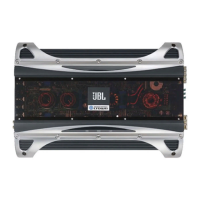
Do you have a question about the JBL BPx2200.1 and is the answer not in the manual?
| RMS power at 4 ohms | 123.5W x 4 channels |
|---|---|
| Signal-to-noise ratio | 76.64dBA |
| RMS power at 2 ohms | 169W x 4 channels |
| Dynamic power at 4 ohms | 385W x 2 channels |
|---|---|
| Maximum input signal | 5.9V |
| Maximum sensitivity | 250mV |
| Effective damping factor | 6.383 at 4 ohms |
|---|---|
| Frequency response | 16.6Hz – 500kHz |
| Dimensions (L x W x H) | 12-1/4" x 17" x 2-9/16" |
| RMS power at 4 ohms | 334W x 2 channels |
|---|---|
| Signal-to-noise ratio | 63dBA |
| RMS power at 1 ohm | 1022W x 1 channel |
| Dynamic power at 4 ohms | 1312W x 1 channel |
|---|---|
| Maximum input signal | 7V |
| Maximum sensitivity | 264mV |
| Effective damping factor | 6.179 at 4 ohms |
|---|---|
| Frequency response | 21Hz – 320Hz |
| Dimensions (L x W x H) | 12-1/4" x 17" x 2-9/16" |
| RMS power at 4 ohms | 180W x 2 channels |
|---|---|
| Signal-to-noise ratio | 79.5dBA |
| RMS power at 2 ohms | 290W x 2 channels |
| Dynamic power at 4 ohms | 692W x 1 channel |
|---|---|
| Maximum input signal | 5.95V |
| Maximum sensitivity | 264mV |
| Effective damping factor | 6.274 at 4 ohms |
|---|---|
| Frequency response | 10Hz – 97.5kHz |
| Dimensions (L x W x H) | 12-1/4" x 17" x 2-9/16" |
| RMS power at 4 ohms | 650W x 2 channels |
|---|---|
| Signal-to-noise ratio | 67dBA |
| RMS power at 1 ohm | 1810W x 1 channel |
| Dynamic power at 4 ohms | 2940W x 1 channel |
|---|---|
| Maximum input signal | 7V |
| Maximum sensitivity | 250mV |
| Effective damping factor | 6.28 at 4 ohms |
|---|---|
| Frequency response | 22Hz – 302Hz |
| Dimensions (L x W x H) | 12-1/4" x 21-5/8" x 2-9/16" |
| RMS power at 4 ohms | 237W x 2 channels |
|---|---|
| Signal-to-noise ratio | 66.4dBA |
| RMS power at 1 ohm | 674W x 1 channel |
| Dynamic power at 4 ohms | 790W x 1 channel |
|---|---|
| Maximum input signal | 6.2V |
| Maximum sensitivity | 280mV |
| Effective damping factor | 6.187 at 4 ohms |
|---|---|
| Frequency response | 25.4Hz – 340Hz |
| Dimensions (L x W x H) | 12-1/4" x 13" x 2-9/16" |
Essential safety precautions and best practices for amplifier installation, including eye protection and power disconnection.
Guidance on selecting a mounting site, ensuring proper cooling, and making secure power, remote, and speaker connections.
Diagram illustrating how to configure the BPx amplifier for 2-channel mode to drive a pair of subwoofers.
Diagram for configuring the BPx amplifier in bridged (mono) mode to drive a single subwoofer (2 ohms or greater).
Diagram for configuring the BPx amplifier in parallel mode to drive a single subwoofer (less than 2 ohms).
Diagram showing the Px600.2 amplifier set to stereo mode for driving a pair of full-range speakers.
Diagram showing the Px600.2 amplifier set to bridged (mono) mode for driving a single subwoofer (4 ohms or greater).
Diagram illustrating the Px300.4 amplifier in stereo mode for driving front and rear pairs of speakers.
Diagram showing the Px300.4 amplifier driving a stereo component system and a subwoofer.
Explains how to set output modes (2-channel, bridge, parallel) based on system configuration and impedance.
Guide to adjusting crossover frequency and slope for optimal sound filtering and speaker protection.
Instructions on adjusting input level for optimal amplifier performance and preventing distortion.
Explanation of the DBO feature for enhancing low-frequency response and conserving power.
Optional installation guide for attaching neon lighting tubes to the amplifier's chassis.
Identifies common symptoms, likely causes, and solutions for amplifier operational problems.
Detailed technical specifications for all Px and BPx series amplifier models, including power, dimensions, and frequency response.
